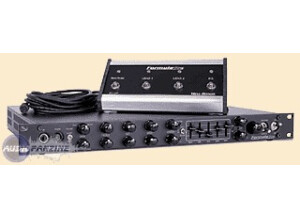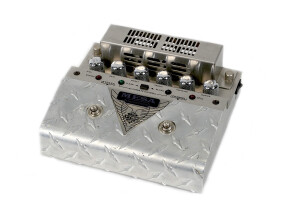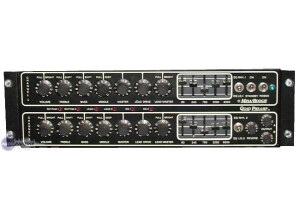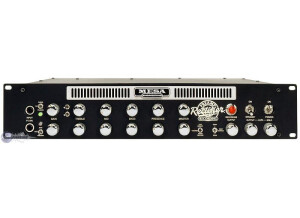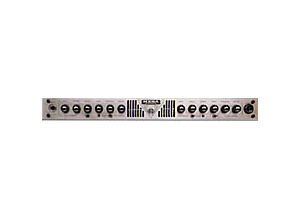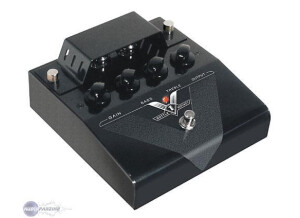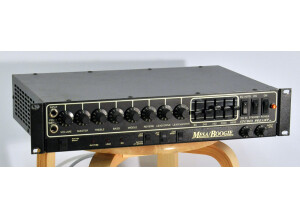Tech. sheet
- Manufacturer: Mesa Boogie
- Model: TriAxis
- Category: Tube Guitar Preamps
- Other names:tri axis, triaxisv2, triaxis v 2
We have no technical specifications for this product
but your help will be much welcomed
»
Videos
User reviews
4.6/5(10 reviews)
5
70 %
4
20 %
3
10 %
2
1
Mesa Boogie Triaxis
Published on 09/24/02 at 15:00Mom and Pop type music shop (castle music) in Santa Barbara California, in approximately 1989. Price paid, about $1,000 new, whatever full retail was at the time.
I bought this unit to finish the stereo rack half stack I was putting together.
My Rack:
Space 1: Furman Power Conditioner/pwr strip
Space 2: 1/2 space korg tuner, 1/2 space Boss compression/limiter
Space 3: 1/2 space dbx stereo noise gate, sholtz midi octopuss w/2 loops
Space 4: Rocktron Intelliflex
Space 5: AKG Uhf Wireless Mic
Space 6: Mesa Boogie Triaxis
Space 7/8: Mesa Boogie Simul Class 2:90
Cabinet: Stereo Mesa Boogie 4-12
The triaxis nicely complimented the Boogie Simul Class 2:90 power section, and also supports...…
I bought this unit to finish the stereo rack half stack I was putting together.
My Rack:
Space 1: Furman Power Conditioner/pwr strip
Space 2: 1/2 space korg tuner, 1/2 space Boss compression/limiter
Space 3: 1/2 space dbx stereo noise gate, sholtz midi octopuss w/2 loops
Space 4: Rocktron Intelliflex
Space 5: AKG Uhf Wireless Mic
Space 6: Mesa Boogie Triaxis
Space 7/8: Mesa Boogie Simul Class 2:90
Cabinet: Stereo Mesa Boogie 4-12
The triaxis nicely complimented the Boogie Simul Class 2:90 power section, and also supports...…
Read more
Mom and Pop type music shop (castle music) in Santa Barbara California, in approximately 1989. Price paid, about $1,000 new, whatever full retail was at the time.
I bought this unit to finish the stereo rack half stack I was putting together.
My Rack:
Space 1: Furman Power Conditioner/pwr strip
Space 2: 1/2 space korg tuner, 1/2 space Boss compression/limiter
Space 3: 1/2 space dbx stereo noise gate, sholtz midi octopuss w/2 loops
Space 4: Rocktron Intelliflex
Space 5: AKG Uhf Wireless Mic
Space 6: Mesa Boogie Triaxis
Space 7/8: Mesa Boogie Simul Class 2:90
Cabinet: Stereo Mesa Boogie 4-12
The triaxis nicely complimented the Boogie Simul Class 2:90 power section, and also supports real time midi control which allowed me to make full use of my Art expression pedal unit. On a particular channel I can assign either of two pedals to control a triaxis parameter in real time. I.e., a volume pedal that effects master volume, hence absolutely no change in tonal qualities, and a second pedal which simultaneously brings gain up, bass down, trebel up, 5 band eq up, presence down...for example... These pedals are also used to control real time parameters on the Intelliflex, and the midi octopuss serves to switch non-midi modules as well simultaneously.
Conceptually, to have 90 channels of tube preamp, midi switchable, well what can I say...that's like having 45 two channel tube heads all set at different tones at your command by channel switching! In practice you end up settling on say 10-20 different tones, but duplicating these settings on some channels and using different intelliflex settings to create a different sounding channel. The key is your in charge of what your 20 differnt tones sound like as opposed to say a modelling amp like line 6 or vox in which they tell you what your 20 different tones must sound like. With a Triaxis you can do way better, and have total control over your sound.
I did extensive comparison between the Triaxis and the Marshall JMP midi preamp, taking both units home and playing them for days. I have always been a Marshall man at heart, having owned JCM 800's at three different times. I had also owned a Boogie Mark IV, and that is how I got into Boogie as well. In the end, the Triaxis not only sounded better, was more versatile sound wise, and had superior options for real time midi expression.
HOw does it sound? Well, I won't spend much time here...it sounds as good as any boogie sounds...this unit is able to reproduce most any boogie product that has come out. There are about 8-9 different amp modes to choose from that you can assign to any of the 90 banks. Combined with the three different modes on the Simulclass 2:90 that gives alot of combinations. I can find any sound I want here from the cleanest cleans to the heaviest type triple rectifier type sounds (not sure if it is actually a triple rect, but it sounds as intense as one). The thing I really love is that I can have controlled third harmonic feedback (the good kind of feedback) at will.... reminds me of why I loved my Marshalls. Find the right spot on the stage and your Triaxis/2:90 is singing for as long as you want.
Now here is the deal....I enjoyed this setup for many years...and 6 months ago was considering selling it all in favor of a more simplistic rig...my hair is shorter now, and I'm not doing the heavy rock thing any more...natural evolution to the blues thing, so I was in favor of getting a combo of some sort. Well after researching many rigs and settling on a Fender Hot Rod Deville 410,... I decided to try an experiment on my triaxis that I had never done... the midi dump and upload! I found some websites with artist settings that could be downloaded to my computer, and uploaded to the triaxis automatically via the midi cables.
Damn!
This thing sounds so frigging good now..what great blues tones that I had never dialed in! I guess it makes sense that these artists with their roadies can really play with these units and dial in fantastic different sounds. So much better than what I had found. I want a do over..want to go back to my heavy rock days and re gig with these new settings. Now I have files saved on my computer with my original settings and my new settings..and I can reload and alternate between the two at will. Hmm what gig tonight? Jazz..upload the file...tonight, OzzFest? Upload the file....
With so many parameters to dial in ... I would say that the only part of the triaxis that I can comment on in any negative sense would be the interface for parameter changes....there are no knobs to twist...there are left and right arrows....This makes it slightly more cumbersome than a simple twist of a knob.
This is no longer important to me since I now use the shareware software I found in order to make paramter changes from my computer. A simple slider exists for each paramter...and as you slide the know on your cpu, the parameter is changing on your triaxis and available for a sound check. But for many years I did not use this feature.
Knobs would make this unit a little easier to dial in..but keep in mind this is a very minor complaint....in practice it is easy enought to make minor tweeks to sounds....i.e. at a practice or gig need a little more or a little less? No problem to dial this in.
For initial setup of channel parameters, I guess I am saying this is a time consuming effort if you don't have the use of the shareware and a computer....
The unit does come with some very nice factory presets..so in reality one need not do any extensive setup.
I have owned this stack I put together for over ten years. I have gigged out with it exptensively....I have never had to change the tubes! Never had a technical difficulty with it. It's rock solid. It loks sharp in the rack! Probably because there are no knobs...very cool look.
So..I had loved my triaxis..was considering selling it for a blues specific sounding amp..and now have fallen in love with it all over again. I am getting better tones and response out of it than any other blues amp I have tried. Some have critisized the clean sounds saying they don't compare to some of the Fender's with lots of headroom and sparkle...that is not my experience but the key is to use a simulclass 2:90 in the "full" mode not the half mode. It is absolutely the best sounding, most versatile, most feature rich rig I have ever played with.
Meanwhile, if I get a fender hot rod deville..it will only be a practice amp for watching tv in the living room and for going to practice...my stack is big and heavy for moving around for anything less than a gig.
This review was originally published on http://www.musicgearreview.com
I bought this unit to finish the stereo rack half stack I was putting together.
My Rack:
Space 1: Furman Power Conditioner/pwr strip
Space 2: 1/2 space korg tuner, 1/2 space Boss compression/limiter
Space 3: 1/2 space dbx stereo noise gate, sholtz midi octopuss w/2 loops
Space 4: Rocktron Intelliflex
Space 5: AKG Uhf Wireless Mic
Space 6: Mesa Boogie Triaxis
Space 7/8: Mesa Boogie Simul Class 2:90
Cabinet: Stereo Mesa Boogie 4-12
The triaxis nicely complimented the Boogie Simul Class 2:90 power section, and also supports real time midi control which allowed me to make full use of my Art expression pedal unit. On a particular channel I can assign either of two pedals to control a triaxis parameter in real time. I.e., a volume pedal that effects master volume, hence absolutely no change in tonal qualities, and a second pedal which simultaneously brings gain up, bass down, trebel up, 5 band eq up, presence down...for example... These pedals are also used to control real time parameters on the Intelliflex, and the midi octopuss serves to switch non-midi modules as well simultaneously.
Conceptually, to have 90 channels of tube preamp, midi switchable, well what can I say...that's like having 45 two channel tube heads all set at different tones at your command by channel switching! In practice you end up settling on say 10-20 different tones, but duplicating these settings on some channels and using different intelliflex settings to create a different sounding channel. The key is your in charge of what your 20 differnt tones sound like as opposed to say a modelling amp like line 6 or vox in which they tell you what your 20 different tones must sound like. With a Triaxis you can do way better, and have total control over your sound.
I did extensive comparison between the Triaxis and the Marshall JMP midi preamp, taking both units home and playing them for days. I have always been a Marshall man at heart, having owned JCM 800's at three different times. I had also owned a Boogie Mark IV, and that is how I got into Boogie as well. In the end, the Triaxis not only sounded better, was more versatile sound wise, and had superior options for real time midi expression.
HOw does it sound? Well, I won't spend much time here...it sounds as good as any boogie sounds...this unit is able to reproduce most any boogie product that has come out. There are about 8-9 different amp modes to choose from that you can assign to any of the 90 banks. Combined with the three different modes on the Simulclass 2:90 that gives alot of combinations. I can find any sound I want here from the cleanest cleans to the heaviest type triple rectifier type sounds (not sure if it is actually a triple rect, but it sounds as intense as one). The thing I really love is that I can have controlled third harmonic feedback (the good kind of feedback) at will.... reminds me of why I loved my Marshalls. Find the right spot on the stage and your Triaxis/2:90 is singing for as long as you want.
Now here is the deal....I enjoyed this setup for many years...and 6 months ago was considering selling it all in favor of a more simplistic rig...my hair is shorter now, and I'm not doing the heavy rock thing any more...natural evolution to the blues thing, so I was in favor of getting a combo of some sort. Well after researching many rigs and settling on a Fender Hot Rod Deville 410,... I decided to try an experiment on my triaxis that I had never done... the midi dump and upload! I found some websites with artist settings that could be downloaded to my computer, and uploaded to the triaxis automatically via the midi cables.
Damn!
This thing sounds so frigging good now..what great blues tones that I had never dialed in! I guess it makes sense that these artists with their roadies can really play with these units and dial in fantastic different sounds. So much better than what I had found. I want a do over..want to go back to my heavy rock days and re gig with these new settings. Now I have files saved on my computer with my original settings and my new settings..and I can reload and alternate between the two at will. Hmm what gig tonight? Jazz..upload the file...tonight, OzzFest? Upload the file....
With so many parameters to dial in ... I would say that the only part of the triaxis that I can comment on in any negative sense would be the interface for parameter changes....there are no knobs to twist...there are left and right arrows....This makes it slightly more cumbersome than a simple twist of a knob.
This is no longer important to me since I now use the shareware software I found in order to make paramter changes from my computer. A simple slider exists for each paramter...and as you slide the know on your cpu, the parameter is changing on your triaxis and available for a sound check. But for many years I did not use this feature.
Knobs would make this unit a little easier to dial in..but keep in mind this is a very minor complaint....in practice it is easy enought to make minor tweeks to sounds....i.e. at a practice or gig need a little more or a little less? No problem to dial this in.
For initial setup of channel parameters, I guess I am saying this is a time consuming effort if you don't have the use of the shareware and a computer....
The unit does come with some very nice factory presets..so in reality one need not do any extensive setup.
I have owned this stack I put together for over ten years. I have gigged out with it exptensively....I have never had to change the tubes! Never had a technical difficulty with it. It's rock solid. It loks sharp in the rack! Probably because there are no knobs...very cool look.
So..I had loved my triaxis..was considering selling it for a blues specific sounding amp..and now have fallen in love with it all over again. I am getting better tones and response out of it than any other blues amp I have tried. Some have critisized the clean sounds saying they don't compare to some of the Fender's with lots of headroom and sparkle...that is not my experience but the key is to use a simulclass 2:90 in the "full" mode not the half mode. It is absolutely the best sounding, most versatile, most feature rich rig I have ever played with.
Meanwhile, if I get a fender hot rod deville..it will only be a practice amp for watching tv in the living room and for going to practice...my stack is big and heavy for moving around for anything less than a gig.
This review was originally published on http://www.musicgearreview.com
See less
00
»
One of the best tube preamps out there
Published on 09/03/11 at 08:115 preamp tubes. 8 channels. 90 presets. midi. fx loop. And most any routing you could need. In terms of tube preamps, this is a fairly modern unit in terms of features. It's made to be used in conjuction with the most modern gear. Most mesa stuff follows this design concept, which is kind of a no corners cut philosophy. While it is technically a digital unit, the audio path is still all tube. This is really mesa's best effort to cram all its best amps into one preamp unit. And when paired with a good mesa power amp, this should theoretically get you all those sounds.
UTILIZATION
One thing I really like about this unit is the ease of control. Every parameter is controllable...…
UTILIZATION
One thing I really like about this unit is the ease of control. Every parameter is controllable...…
Read more
5 preamp tubes. 8 channels. 90 presets. midi. fx loop. And most any routing you could need. In terms of tube preamps, this is a fairly modern unit in terms of features. It's made to be used in conjuction with the most modern gear. Most mesa stuff follows this design concept, which is kind of a no corners cut philosophy. While it is technically a digital unit, the audio path is still all tube. This is really mesa's best effort to cram all its best amps into one preamp unit. And when paired with a good mesa power amp, this should theoretically get you all those sounds.
UTILIZATION
One thing I really like about this unit is the ease of control. Every parameter is controllable in real time just like a real amp and Mesa has taken every effort to make it feel like a real amp. There aren't any crazy menus to wade around in for hours. This isn't the easiest preamp to use, but given all it can do, it sure could be a lot more complicated. The manual is great, like most Mesa manuals. There's a lot of sounds in here and the literature reflects that.
SOUNDS
I'm using this preamp in a rig right now with a Mesa Strategy power amp and a VHT fat bottom 4x12. It's quite loud, obviously. But I reserve this rig for really big shows. I control the Triaxis with a Ground Control Pro.
I feel like I should just go through each channel.
R Green - This is really Mesa's shot at a blackface clean. They tend to do this very well, however while I really like this channel, I feel like the clean channel on the Studio preamp they make is better.
R Yellow - Not a fan of this one. If you've played the Mark IV clean channel you know what I mean. It's just meh.
Lead 1 - This is your early santana and overdriven fender sounds. You can get some good clean sounds out of it though. I play a lot of santana covers and this channel gets that tone in spades.
Lead 2 - The Green and yellow channel are basically your Mark II through Mark IV sounds. Metallica and Dream Theater is your tonal pallete here. In my opinion this is the best sounds in the box right here. The high gain sounds of the Mark series are delivered with a vengeance.
Lead 2 red - Recto tone. Plain and simple. And it's actually done pretty well. Although for anyone who's never played an older Recto, this does not sound like the new ones. This is based on revision 1 so it has more mid action going on.
OVERALL OPINION
The cleans on the triaxis are pretty good but not insane. The mid gain and high gain sounds range from great to amazing. Value is good but not cheap. This is not really a budget preamp and I would rather recommend the Studio preamp for people on short change. That said I really love this thing. It has the classic mesa sounds and does most of them really well. Unfortunately if you are looking for something other than mesa/blackface tones this will NOT do it. Forget about it. Go get a JMP preamp or something else. Otherwise, this is your guy.
UTILIZATION
One thing I really like about this unit is the ease of control. Every parameter is controllable in real time just like a real amp and Mesa has taken every effort to make it feel like a real amp. There aren't any crazy menus to wade around in for hours. This isn't the easiest preamp to use, but given all it can do, it sure could be a lot more complicated. The manual is great, like most Mesa manuals. There's a lot of sounds in here and the literature reflects that.
SOUNDS
I'm using this preamp in a rig right now with a Mesa Strategy power amp and a VHT fat bottom 4x12. It's quite loud, obviously. But I reserve this rig for really big shows. I control the Triaxis with a Ground Control Pro.
I feel like I should just go through each channel.
R Green - This is really Mesa's shot at a blackface clean. They tend to do this very well, however while I really like this channel, I feel like the clean channel on the Studio preamp they make is better.
R Yellow - Not a fan of this one. If you've played the Mark IV clean channel you know what I mean. It's just meh.
Lead 1 - This is your early santana and overdriven fender sounds. You can get some good clean sounds out of it though. I play a lot of santana covers and this channel gets that tone in spades.
Lead 2 - The Green and yellow channel are basically your Mark II through Mark IV sounds. Metallica and Dream Theater is your tonal pallete here. In my opinion this is the best sounds in the box right here. The high gain sounds of the Mark series are delivered with a vengeance.
Lead 2 red - Recto tone. Plain and simple. And it's actually done pretty well. Although for anyone who's never played an older Recto, this does not sound like the new ones. This is based on revision 1 so it has more mid action going on.
OVERALL OPINION
The cleans on the triaxis are pretty good but not insane. The mid gain and high gain sounds range from great to amazing. Value is good but not cheap. This is not really a budget preamp and I would rather recommend the Studio preamp for people on short change. That said I really love this thing. It has the classic mesa sounds and does most of them really well. Unfortunately if you are looking for something other than mesa/blackface tones this will NOT do it. Forget about it. Go get a JMP preamp or something else. Otherwise, this is your guy.
See less
10
»
Solid build solid buy
Published on 04/06/11 at 17:02This is an all in one Mesa Boogie bonanza! This preamp is covering a lot of history with Mesa's tones throughout the years. Though it does have a slight limitation of the feel of each of the offerings such as the early Mark l series or the Mark llc+, it still comes very close to those original tones.
FEATURES:
Handbuilt in Petaluma, California
5x12AX7
8 Modes (MK I / Vintage Fat Clean, MK IV / Hyper-Clean, MK I / Lead, MK I / Gain Boost,Classic British Lead, MK IV / Medium Gain, MK IIC+/ Classic High Gain & MK III / Searing Gain)
90 User Preset Locations/128 Midi Program Locations
Midi In/Out/Thru
Midi Continuous Control (any or all parameters)
Midi Data Transfer
Phantom Power...…
FEATURES:
Handbuilt in Petaluma, California
5x12AX7
8 Modes (MK I / Vintage Fat Clean, MK IV / Hyper-Clean, MK I / Lead, MK I / Gain Boost,Classic British Lead, MK IV / Medium Gain, MK IIC+/ Classic High Gain & MK III / Searing Gain)
90 User Preset Locations/128 Midi Program Locations
Midi In/Out/Thru
Midi Continuous Control (any or all parameters)
Midi Data Transfer
Phantom Power...…
Read more
This is an all in one Mesa Boogie bonanza! This preamp is covering a lot of history with Mesa's tones throughout the years. Though it does have a slight limitation of the feel of each of the offerings such as the early Mark l series or the Mark llc+, it still comes very close to those original tones.
FEATURES:
Handbuilt in Petaluma, California
5x12AX7
8 Modes (MK I / Vintage Fat Clean, MK IV / Hyper-Clean, MK I / Lead, MK I / Gain Boost,Classic British Lead, MK IV / Medium Gain, MK IIC+/ Classic High Gain & MK III / Searing Gain)
90 User Preset Locations/128 Midi Program Locations
Midi In/Out/Thru
Midi Continuous Control (any or all parameters)
Midi Data Transfer
Phantom Power (for Footcontroller)
Programmable FX Loop w/Stereo Returns
4 Programmable Function Switches (Controls Smart Power™ “Deep, Half Drive or Modern” on select MESA Power amps or controls other outboard gear)
Stereo Main & Recording Outputs
Available as:
TriAxis Pre-Amp • 1 Rack Space
UTILIZATION
Eight Preamp Modes
Rhythm
Green
Vintage Fat Rhythm (Mark I, Black-face)
Rhythm Yellow
Modern hyper-clean Rhythm (Mark IV)
Lead 1 Green
Vintage Mark I Lead
Lead 1 Yellow
Mark 1 Gain Boost
Lead 1
Red
Classic Boogie Lead
Lead 2 Green
Medium Gain Boogie Lead
Lead 2 Yellow
Classic Boogie Lead (Mark IIC+/Mark IV)
Lead 2
Red
Searing Boogie Lead
SOUNDS
This unit can produce some searing Mesa sounds in a one space preamp rack unit. Couple this with one of Mesa's power amps and you will have nice arsenal of Mesa flavors at your disposal.
I know that some people aren't a fan of the early Mark series amps but the ones they have simulated in this unit are amazing. However, if you are going to do this unit any justice you will have to play it on the Lead 2 red mode. Here you will hear what this thing was made to do and that is balls to the walls Mesa heavy riffing. Couple this with one of mesa's 4x12 cab with Vintage 30 Celestion speakers and the mesa power amp and you will be good to go. Deep rich chunky rhythm is what makes Mesa so unique and all of that sweet tone-age is pronounced in this unit.
OVERALL OPINION
I would recommend this unit to any Mesa Boogie lover and especially the Mark llC+ users who don't want to put out the money for a real one or simply can't find one. At new these units come in at around $2000 which is kind of high for a preamp you would think. However, this unit does cover a ton of ground. Why should you buy this over a Mark V which is less money and comes with a power amp....well this is midi function able.
My personal preference is to buy a used Dual Recto or a Mark lll which is my favorite two amps that Mesa ever produced. For the price of those two you could probably come close to one of these new.
FEATURES:
Handbuilt in Petaluma, California
5x12AX7
8 Modes (MK I / Vintage Fat Clean, MK IV / Hyper-Clean, MK I / Lead, MK I / Gain Boost,Classic British Lead, MK IV / Medium Gain, MK IIC+/ Classic High Gain & MK III / Searing Gain)
90 User Preset Locations/128 Midi Program Locations
Midi In/Out/Thru
Midi Continuous Control (any or all parameters)
Midi Data Transfer
Phantom Power (for Footcontroller)
Programmable FX Loop w/Stereo Returns
4 Programmable Function Switches (Controls Smart Power™ “Deep, Half Drive or Modern” on select MESA Power amps or controls other outboard gear)
Stereo Main & Recording Outputs
Available as:
TriAxis Pre-Amp • 1 Rack Space
UTILIZATION
Eight Preamp Modes
Rhythm
Green
Vintage Fat Rhythm (Mark I, Black-face)
Rhythm Yellow
Modern hyper-clean Rhythm (Mark IV)
Lead 1 Green
Vintage Mark I Lead
Lead 1 Yellow
Mark 1 Gain Boost
Lead 1
Red
Classic Boogie Lead
Lead 2 Green
Medium Gain Boogie Lead
Lead 2 Yellow
Classic Boogie Lead (Mark IIC+/Mark IV)
Lead 2
Red
Searing Boogie Lead
SOUNDS
This unit can produce some searing Mesa sounds in a one space preamp rack unit. Couple this with one of Mesa's power amps and you will have nice arsenal of Mesa flavors at your disposal.
I know that some people aren't a fan of the early Mark series amps but the ones they have simulated in this unit are amazing. However, if you are going to do this unit any justice you will have to play it on the Lead 2 red mode. Here you will hear what this thing was made to do and that is balls to the walls Mesa heavy riffing. Couple this with one of mesa's 4x12 cab with Vintage 30 Celestion speakers and the mesa power amp and you will be good to go. Deep rich chunky rhythm is what makes Mesa so unique and all of that sweet tone-age is pronounced in this unit.
OVERALL OPINION
I would recommend this unit to any Mesa Boogie lover and especially the Mark llC+ users who don't want to put out the money for a real one or simply can't find one. At new these units come in at around $2000 which is kind of high for a preamp you would think. However, this unit does cover a ton of ground. Why should you buy this over a Mark V which is less money and comes with a power amp....well this is midi function able.
My personal preference is to buy a used Dual Recto or a Mark lll which is my favorite two amps that Mesa ever produced. For the price of those two you could probably come close to one of these new.
See less
00
»
Published on 02/05/04 at 00:41 (This content has been automatically translated from French)
Pramplification all lamps: 5 12AX7 lamps
connectors etc ... see website mesa / boogie
USE
Very simple, we regret the absence of the pots
SONORITS
For THE sound mesa, it is imperative add to it a 2:90 amp and cabinet Mesa Recto 4x12, otherwise you may be the.
The clean sounds are amazing and you must add a good multi dnaturer not sound (type TC or Lexicon CForce ...).
For sound metal, this is the stuff you need
NOTICE GLOBAL
I use it for 2 years, I have tried a lot of amps / pramplis rack before and I'll try not others.
If I knew rather, I would have bought had since the beginning.
on the other hand, be careful what you put him in the ass: 2:90 and absolutely...…
connectors etc ... see website mesa / boogie
USE
Very simple, we regret the absence of the pots
SONORITS
For THE sound mesa, it is imperative add to it a 2:90 amp and cabinet Mesa Recto 4x12, otherwise you may be the.
The clean sounds are amazing and you must add a good multi dnaturer not sound (type TC or Lexicon CForce ...).
For sound metal, this is the stuff you need
NOTICE GLOBAL
I use it for 2 years, I have tried a lot of amps / pramplis rack before and I'll try not others.
If I knew rather, I would have bought had since the beginning.
on the other hand, be careful what you put him in the ass: 2:90 and absolutely...…
Read more
Pramplification all lamps: 5 12AX7 lamps
connectors etc ... see website mesa / boogie
USE
Very simple, we regret the absence of the pots
SONORITS
For THE sound mesa, it is imperative add to it a 2:90 amp and cabinet Mesa Recto 4x12, otherwise you may be the.
The clean sounds are amazing and you must add a good multi dnaturer not sound (type TC or Lexicon CForce ...).
For sound metal, this is the stuff you need
NOTICE GLOBAL
I use it for 2 years, I have tried a lot of amps / pramplis rack before and I'll try not others.
If I knew rather, I would have bought had since the beginning.
on the other hand, be careful what you put him in the ass: 2:90 and absolutely one-sided mesa 4x12!
connectors etc ... see website mesa / boogie
USE
Very simple, we regret the absence of the pots
SONORITS
For THE sound mesa, it is imperative add to it a 2:90 amp and cabinet Mesa Recto 4x12, otherwise you may be the.
The clean sounds are amazing and you must add a good multi dnaturer not sound (type TC or Lexicon CForce ...).
For sound metal, this is the stuff you need
NOTICE GLOBAL
I use it for 2 years, I have tried a lot of amps / pramplis rack before and I'll try not others.
If I knew rather, I would have bought had since the beginning.
on the other hand, be careful what you put him in the ass: 2:90 and absolutely one-sided mesa 4x12!
See less
00
»












